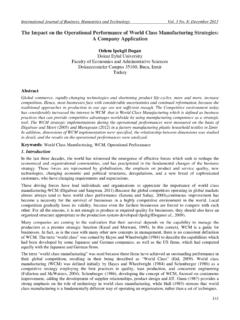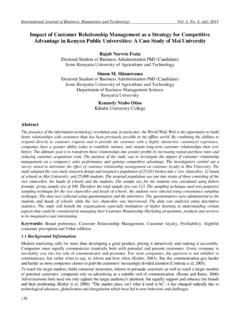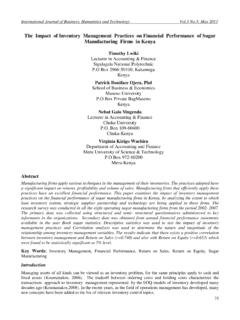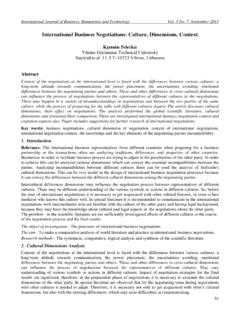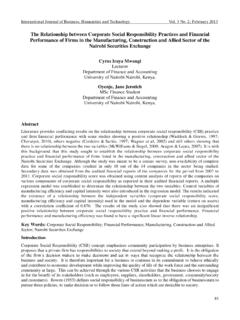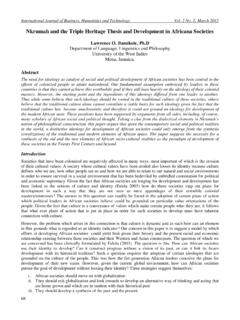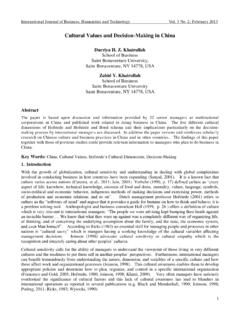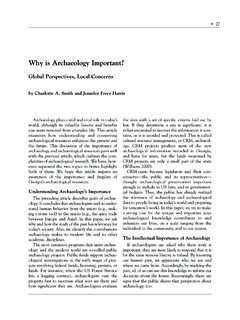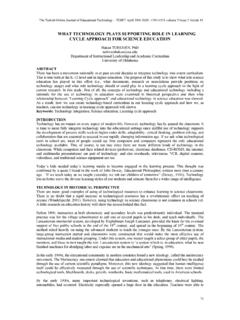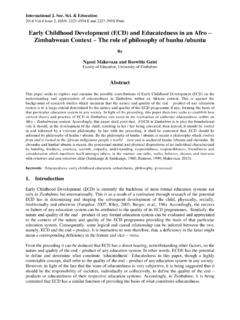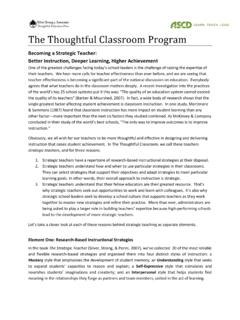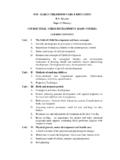Transcription of Learning With Technology from a Constructivist …
1 International Journal of Business, Humanities and Technology Vol. 3 No. 1; January 2013 52 Learning with Technology from a Constructivist Point of View Dr. Nidal Zaki Amarin Dr. Rima Issa Ghishan Department of Educational Sciences Faculty of Arts Al-Zaytoonah Private University of Jordan Jordan Abstract Technology is becoming an integral part of the educational realm; this article provides an overview of constructivism and its implications for learner s practices inside the classroom. It describes the educational features of constructivism with its basic forms and/or variations. It then elucidates the Constructivist view of Technology , Learning , and the relationship among them. It will provide various definitions of Constructivist approaches, and explains the assumption and principles of Constructivist pedagogy.
2 Finally, this study presents how constructivism as a Learning theory can guide the process of Learning in classroom situations. Key words: Educational Technology , Constructivism Approaches Introduction Globalization and rapid changes in Technology have created a need for adults to update their skill sets for career advancement and to be prepared to make broad decisions about complex problems using myriad of information (Brown, Green, & Lauder, 2001). Adults are enrolling in higher institutions, in response to the changing demands of the workplace and to concerns coming with the emerging knowledge economy. Today s students have access to a broad range of information, knowledge, ideas, and opinions well beyond their classroom. Never before have learners been able to interact so closely with the instructors, mentors, subject-matter experts, and peers, and yet be so dispersed.
3 And as the possibilities for educational institutions have increased, so have the challenged. Theoretical Framework The theoretical foundation used to study the process of subject matter beliefs shaping instruction in educational institutions was synthesized under a Constructivist conceptual framework. Robinson, Molenda and Rezabek (2008) explain that facilitating Learning puts the emphasis on the learners and their interests and abilities (or disabilities) ( ), with defining their Learning problem and controlling their internal mental processes, and teachers supporting this process. This Constructivist view and shows teachers and learners as collaborations in the Learning process and implies the need for student motivation (Bobinson et al, 2008). Constructivism values social interaction in the Learning process, promoted by Vygotsky with the assumption that knowledge is constructed by learners as they attempt to make sense of their experiences (Driscoll, as cited in Robinson et al.)
4 , 2008, ). Constructivism differs from cognitivism essentially in the subject nature of this knowledge (von Glaserfeld, as cited in Robinson et al.,). Driscoll highlighted these essential Constructivist elements: Learning in relevant environments, social negotiation opportunities (collaboration), the need for multiple perspectives/representations, encouragement of ownership of Learning and self-awareness (reflection). Practices include scaffolding, modeling and mentoring (Dennen, as cited in Robinson et al.,). The relevance of cognitivism is that highlights message design issues such as structuring knowledge and emphasizing key points with advanced organizers, chunking, and helpful visuals (Silber &Foshay, as cited in Robinson et al.,). Also, linking new knowledge to prior knowledge and assimilating and strengthening retention and transfer of this new knowledge are recommended by Foshay, Silber and Stelnecki( as cited in Robinson et al.
5 ,). Centre for Promoting Ideas, USA 53 Molenda and Robinson (2008) explain educational Technology s distinctive ethical concerns focus on the processes of creating instructional materials and Learning environments and on relations with learners during the use of those materials and environments ( ). They continue that critical theory highlights the need for sensitivity to power relationships in Learning environments and that learners need to share this power; behaviorist Learning theory shifted the focus from the group to the individual and cognitive and Constructivist approaches also emphasize that the learner is unique. Facilitating Learning is about the intended audience: students are the the core of our activities as educational technologists and truly facilitate Learning Robinson et al.
6 , (2008) emphasize that we must acknowledge the diversity of the individual ( ). Ubiquitous computing and social software offer new Learning opportunities, and are driving changes in the organization of the education system (Attwell, 2007), which are not only technological, but also social, with the learner at the centre (Ebner, Holzinger& Maurer 2007). For educational institutions they need to support the goal of facilitating Learning and by using a systems theory approach educational Technology helps organizations improve performance by recognizing and treating key factors (Molenda& Pershing, 20087). In Constructivist Learning , students construct their own knowledge and there is a purposeful nature to designing Learning activities. A bridge is built between what students already know and what they are expected to learn (Gagnon &Callay 2006:4).
7 Furthermore, educational Technology empowers learners, and teachers, through user-centered design (Molenda& Robinson, 2008). The significance of the social software is that it adapts to its environment and facilitates the trend of open content , which learners become the producers of their own Learning materials (Attwell, 2007). This shift in the Learning production process can be with or without the collaboration of the instructor (Molenda& Pershing, 2008) and the Horizon Report (Johnson, Levine, Smith & Stone, 2010) explains that collaborative technologies reflect current trends for collaborative student work and challenge our roles as educators. Collaborative Learning can be computer mediated, the latter being the most favored (Robinson et al.)
8 , 2008). As Technology becomes integrated into the teaching/ Learning process, the role of the classroom teacher changes noticeably. Classroom teachers become facilitators who assist students in constructing their own understandings and capabilities in carrying out tasks on computer technologies. The shift from lecture and recitation, which often still occurs in secondary classrooms, to coaching automatically supports a Constructivist approach to Learning ; computer encourages the teacher to play the role of a coach (Collins 1991). Salomon (1998) warns against the danger that Technology might redefine the nature of Learning environments and the principles of constructivism the active and thoughtful construction of knowledge into the active but thoughtless compilation of raw information.
9 It is as if Technology might take charge, demanding of Constructivist philosophy and of the psychology of Learning and instruction to follow suit and to adjust themselves to the technological affordances. In similar vein, Schnotz (2002) speculates that even if the general constraints of the human cognitive system will certainly not change as a result of new technologies, learners could have new attitudes and processing habits. Feenberg (1991) sees Technology as a contested field where individuals and social groups can struggle to influence and change technological design, uses and meanings. In fact, one of his key contributions to theorizing Technology is linking philosophically-oriented social theory of Technology with theories of democratization. He argues that while Technology is considered to be a major contributor or contemporary society, it is often believed that it cannot exist within democracy.
10 Feenberg, however, wants to demonstrate that in fact Technology can be part of a process of social democratization and Technology itself can function as a means to meet basic human needs. To him, technologies should contribute to helping produce a more democratic and egalitarian society. More recently, Schmid(2006) explains, a critical theory of Technology is considers that each piece of Technology is constructed by the interaction between its design and how it is appropriated by its users. Thus, Technology use is seen as the result of the interaction of several elements, such as the inherent characteristics of the Technology , teacher s pedagogical beliefs and the kind of pedagogical activities that were designed as a result of them, student s own understandings of the potentials of the Technology and the negotiations between students and the teacher regarding how the Technology should be pedagogically exploited.
